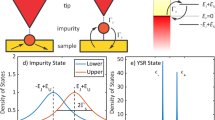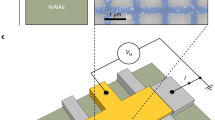Abstract
We present calculations of the tunneling density of states in an anisotropically paired superconductor for two different sample geometries: a semi-infinite system with a single specular wall, and a slab of finite thickness and infinite lateral extent. In both cases we are interested in the effects of surface pair breaking on the tunneling spectrum. We take the stable bulk phase to be of dx 2−y2 symmetry. Our calculations are performed within two different band structure environments: an isotropic cylindrical Fermi surface with a bulk order parameter of the form Δ ∼ k 2x −k 2y , and a nontrivial tight-binding Fermi surface with the order parameter structure coming from an antiferromagnetic spin-fluctuation model. In each case we find additional structures in the energy spectrum coming from the surface layer. These structures are sensitive to the orientation of the surface with respect to the crystal lattice, and have their origins in the detailed form of the momentum and spatial dependence of the order parameter. By means of tunneling spectroscopy, one can obtain information on both the anisotropy of the energy gap, ¦Δ(p)¦, as well as on the phase of the order parameter, Δ(p) = ¦Δ(p)¦ eiϕ(p).
Similar content being viewed by others
References
L. J. Buchholtz and G. Zwicknagl,Phys. Rev. B 23, 5788 (1981).
W. Zhang, J. Kurkijärvi, and E. Thuneberg,Phys. Lett. 109A, 238 (1985).
J. Hara and K. Nagai,Prog. Theor. Phys. 76, 1237 (1986).
W. Zhang, J. Kurkijärvi, and E. Thuneberg,Phys. Rev. B 36, 1987 (1987).
T. Tokuyasu, J. A. Sauls, and D. Rainer,Phys. Rev. B 38, 8823 (1988).
L. J. Buchholtz,Phys. Rev. B 44, 4610 (1991).
N. B. Kopnin, P. I. Soininen, and M. Salomaa,J. Low Temp. Phys. 85, 267 (1991).
C.-R. Hu,Phys. Rev. Lett. 72, 1526 (1994).
S. Kashiwaya and Y. Tanaka,Phys. Rev. B 51, 1350 (1995).
Y. Tanaka and S. Kashiwaya,Phys. Rev. Lett. 74, 3451 (1995).
Y. Nagato and K. Nagai,Phys. Rev. B 51, 16254 (1995).
M. Matsumoto and H. Shiba,J. Phys. Soc. Jpn. 64, 1703 (1995).
L. J. Buchholtz, M. Palumbo, D. Rainer, and J. A. Sauls,J. Low Temp. Phys. 101, 1079 (1995).
J. W. Serene and D. Rainer,Physics Reports 4, 221 (1983).
Y. N. Ovchinnikov,Zh. Eksp. Teor. Fiz. 56, 1590 (1969).
J. Kurkijärvi, D. Rainer, and J. Sauls,Can. J. Phys. 65, 1440 (1987).
R. J. Radtke, S. Ullah, K. Levin, and M. R. Norman,Phys. Rev. B 46, 11975 (1992).
R. J. Radtke and M. R. Norman,Phys. Rev. B 50, 9554 (1994).
M. R. Norman, private communication (1995).
M. F. Atiyah, V. K. Patodi, and I. M. Singer,Proc. Camb. Phil. Soc. 77, 43 (1975).
W. J. Tomasch,Phys. Rev. Lett. 15, 672 (1965).
W. J. Tomasch,Phys. Rev. Lett. 16, 16 (1966).
C. B. Duke,Tunneling in Solids, 1 ed. (Academic Press, New York, 1969), Chap. 7.
Author information
Authors and Affiliations
Rights and permissions
About this article
Cite this article
Buchholtz, L.J., Palumbo, M., Rainer, D. et al. The effect of surfaces on the tunneling density of states of an anisotropically paired superconductor. J Low Temp Phys 101, 1099–1121 (1995). https://doi.org/10.1007/BF00754526
Received:
Revised:
Issue Date:
DOI: https://doi.org/10.1007/BF00754526




